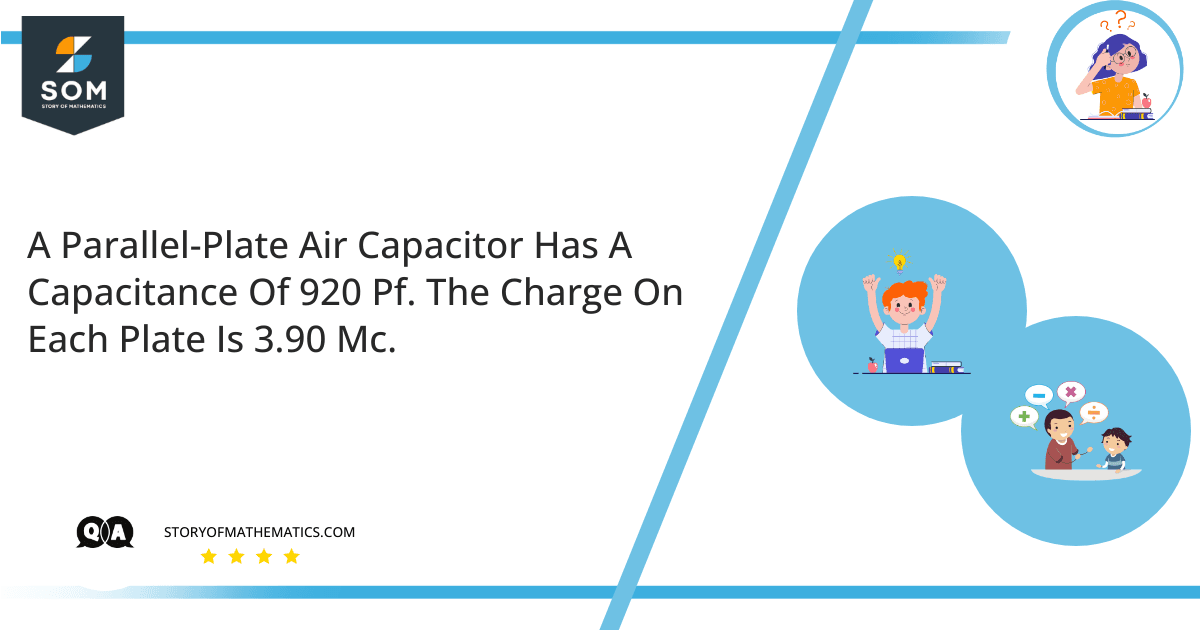
- Calculate the potential difference existing between the plates of the capacitor.
- Keeping the charge constant on each plate of the capacitor, calculate the impact of doubling the separation between capacitor plates on the potential difference.
- Calculate the amount of work that will be required to double the separation between the capacitor plates.
The aim of this article is to find the potential difference between the capacitor plates having a certain charge and the impact of changing the separation between the capacitor plates on the potential difference and the work done to execute it.
The main concept behind this article is the understanding of Charge on Capacitor Q, Capacitance of the Capacitor C, and the Work done W in relation to Potential differenceV across the capacitor plates.
Charge on Capacitor $Q$, Capacitance of the Capacitor $C$ and the Work done $W$ in relation to Potential difference $V$ across the capacitor plates are expressed as the following relation:
Charge on the Capacitor $Q$ is:
\[Q=CV\]
Where:
$Q=$ Charge on Capacitor Plates
$C=$ Capacitance of Capacitor
$V=$ Potential Difference across capacitor plates
The Capacitance of the Capacitor $C$ is:
\[C=\frac{\varepsilon_oA}{d}\]
Where:
$C=$ Capacitance of Capacitor
$\varepsilon_o=$ Permittivity of Free Space
$A=$ Area of the Parallel Plates of
$d=$ Separation between the Capacitor Plates
Work Done to increase the separation between the capacitor plates $W$ is:
\[W=\frac{1}{2}QV\]
Expert Answer
Given that:
Capacitance of Capacitor $C=920pF=920\times{10}^{-12}F$
Charge in each capacitor plate $Q=3.90\mu C=3.9\times{10}^{-6}C$
Part (a)
As per the expression for Charge on the Capacitor $Q$:
\[Q=CV\]
\[V=\frac{Q}{C}\]
\[V=\frac{3.9\times{10}^{-6}C}{920\times{10}^{-12}F}\]
\[Potential\ Difference\ V=4239.13V\]
Part (b)
Given that the Separation between the Capacitor Plates $d$ is doubled, keeping the charge $Q$ constant, so:
\[V_2=\frac{Q}{C_2}\]
As per the expression for Capacitance of the Capacitor $C$, if the distance $d$ is doubled:
\[C_2=\frac{\varepsilon_oA}{2d}=\frac{1}{2}(C)\]
Substituting in the above equation:
\[V_2=\frac{Q}{\dfrac{1}{2}(C)}\]
\[V_2=\frac{2Q}{C}\]
\[V_2=2V\]
\[V_2=\frac{2\times(3.9\times{10}^{-6}C)}{920\times{10}^{-12}F}\]
\[V_2=8478.26V\]
So the Potential difference $V$ is doubled, if the separation between the capacitor plates $d$ is doubled.
Part (c)
In order to calculate the amount of work $W$ that will be required to double the separation between the capacitor plates, we use the following expression:
\[W=\frac{1}{2}QV\]
By substituting the values in the above equation:
\[W=\frac{1}{2}(3.9\times{10}^{-6}C)\times(4239.13V)\]
\[W=8266.3\times{10}^{-6}J\]
\[Work\ Done\ W=0.008266.3J\]
Numerical Result
Part (a) – The Potential difference $V$ existing between the plates of the capacitor is:
\[Potential\ Difference\ V=4239.13V\]
Part (b) – The Potential difference $V$ is doubled if the separation between the capacitor plates $d$ is doubled.
\[V_2\ =\ 2V=\ 8478.26\ V\]
Part (c) – The amount of work $W$ that will be required to double the separation between the capacitor plates $d$ will be:
\[Work\ Done\ W\ =\ 0.008266.3\ J\]
Example
Calculate the potential difference $V$ across the capacitor plates if it has the capacitance of $245\ pF$ and the electric charge on each plate is $0.148\ \mu C$.
Solution
Given that:
Capacitance of Capacitor $C\ =\ 245pF\ =\ 245\times{10}^{-12}F$
Charge in each capacitor plate $Q\ =\ 0.148\mu C\ =\ 0.148\times{10}^{-6}C$
As per the expression for Charge on the Capacitor $Q$:
\[Q=CV\]
\[V=\frac{Q}{C}\]
\[V=\frac{0.148\times{10}^{-6}\ C}{245\times{10}^{-12}F}\]
\[Potential\ Difference\ V=604.08V\]
